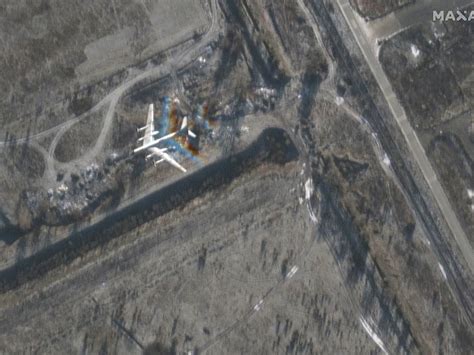
Satellite images confirm Ukraine’s successful drone strikes on a Russian air base, revealing significant damage to aircraft and infrastructure.
New satellite imagery indicates that Ukrainian drones successfully targeted a Russian air base, resulting in notable damage. The images, analyzed by experts, depict the aftermath of the attack, showing apparent damage to aircraft and facilities at the targeted location. The incident marks a significant development in the ongoing conflict, demonstrating Ukraine’s evolving capabilities in employing drone technology for strategic strikes against Russian assets.
The strike targeted the Soltsy-2 air base in the Novgorod region of Russia, located hundreds of kilometers from the Ukrainian border. The satellite images, obtained by various news agencies and defense analysts, reveal at least one Tu-22M3 strategic bomber heavily damaged or destroyed. This particular aircraft is a long-range bomber capable of carrying nuclear weapons, representing a crucial component of Russia’s strategic aviation forces. The extent of the damage suggests that the attack was precisely targeted and inflicted substantial losses on the Russian military.
“The images clearly show fire damage and what appears to be a destroyed aircraft,” stated a defense analyst who reviewed the satellite imagery. “This indicates a successful hit, and the implications are considerable, given the strategic importance of the Tu-22M3 bomber.”
Ukrainian officials have claimed responsibility for the attack, stating that it was part of a broader campaign to degrade Russia’s military capabilities and deter future aggression. While the details of the operation remain confidential, sources suggest that the attack was carried out using domestically produced drones, showcasing Ukraine’s growing expertise in unmanned aerial systems.
The Russian Ministry of Defense has acknowledged the attack but downplayed the extent of the damage. They claimed that only one aircraft was slightly damaged and that there were no casualties. However, the satellite imagery contradicts these claims, revealing a more severe situation.
“The Russian response is typical in these situations,” commented a military expert. “They often try to minimize the impact of such attacks to maintain morale and avoid admitting the effectiveness of Ukrainian military operations.”
The attack on the Soltsy-2 air base raises questions about the vulnerability of Russian military infrastructure to Ukrainian drone strikes. Despite Russia’s extensive air defenses, Ukraine has repeatedly demonstrated its ability to penetrate these defenses and strike targets deep within Russian territory. This suggests potential gaps in Russia’s air defense systems and highlights the challenges of countering drone attacks.
The incident also underscores the evolving nature of modern warfare, where drones play an increasingly prominent role. These unmanned systems offer a cost-effective and versatile means of conducting reconnaissance, surveillance, and offensive operations. Ukraine has effectively leveraged drone technology to compensate for its limited resources and inflict significant damage on Russian forces.
The strategic implications of the attack are far-reaching. The damage to the Tu-22M3 bomber fleet could potentially reduce Russia’s ability to conduct long-range bombing missions. This could affect Russia’s military operations in Ukraine and potentially alter the balance of power in the conflict. Furthermore, the attack sends a clear message to Russia that its military assets are vulnerable to Ukrainian strikes, even at significant distances from the front lines.
In response to the attack, Russia has reportedly increased security measures at its air bases and deployed additional air defense systems. However, it remains to be seen whether these measures will be sufficient to prevent future drone strikes. The ongoing conflict has demonstrated the importance of adapting to new technologies and tactics, and both sides are constantly seeking ways to gain a military advantage.
The use of drones in the conflict has also raised concerns about the potential for escalation. As drone technology becomes more sophisticated and readily available, the risk of miscalculation and unintended consequences increases. It is crucial for both sides to exercise restraint and adhere to international laws of war to prevent the conflict from spiraling out of control.
The attack on the Soltsy-2 air base is a significant development in the ongoing conflict between Ukraine and Russia. It demonstrates Ukraine’s growing military capabilities and the vulnerability of Russian military infrastructure. The incident also underscores the evolving nature of modern warfare and the importance of adapting to new technologies and tactics. As the conflict continues, it is likely that drones will play an increasingly prominent role, shaping the course of the war and potentially altering the balance of power.
Further Details and Context:
The Soltsy-2 air base, situated in the Novgorod region, is a critical component of Russia’s long-range aviation capabilities. The base houses a fleet of Tu-22M3 “Backfire” bombers, supersonic, long-range strategic bombers and maritime strike aircraft. These aircraft are capable of carrying conventional and nuclear weapons and have been used extensively in Russia’s military operations, including in Syria and Ukraine.
The Tu-22M3 bomber is a significant asset for the Russian military, providing it with the ability to strike targets at long distances. The aircraft can carry a variety of weapons, including cruise missiles, anti-ship missiles, and bombs. Its supersonic speed and long range make it a formidable weapon platform.
The loss or damage of even a single Tu-22M3 bomber can have a significant impact on Russia’s military capabilities. These aircraft are expensive to maintain and operate, and replacing them is a lengthy and costly process. The attack on the Soltsy-2 air base has therefore dealt a blow to Russia’s strategic aviation forces.
Ukraine has been using drones extensively in the conflict, for reconnaissance, surveillance, and offensive operations. Ukraine has also demonstrated its ability to develop and deploy advanced drone technology, including long-range strike capabilities. This has allowed Ukraine to strike targets deep within Russian territory, disrupting Russian military operations and infrastructure.
The use of drones in the conflict has also raised ethical and legal concerns. Drones can be used to conduct targeted killings, and there is a risk of civilian casualties. It is therefore crucial for both sides to adhere to international laws of war and take all feasible precautions to minimize civilian harm.
The international community has condemned the use of force in the conflict and has called for a peaceful resolution. However, diplomatic efforts have so far failed to achieve a breakthrough, and the conflict continues to escalate. The attack on the Soltsy-2 air base is a reminder of the ongoing violence and the urgent need for a peaceful solution to the conflict.
Expert Analysis:
Military and defense analysts have weighed in on the significance of the attack, offering insights into its strategic and tactical implications.
“This attack represents a bold move by Ukraine, showcasing their ability to strike strategic assets deep within Russian territory,” said Dr. Anya Petrova, a defense analyst at the Institute for Strategic Studies. “It’s a clear message that no Russian military installation is beyond their reach.”
According to Dr. Petrova, the choice of the Soltsy-2 air base as a target is particularly significant. “The Tu-22M3 bombers stationed there are crucial for Russia’s long-range strike capabilities. Damaging or destroying these aircraft weakens Russia’s ability to project power and conduct bombing missions.”
Other experts have focused on the technological aspects of the attack, highlighting Ukraine’s growing drone capabilities.
“Ukraine has been rapidly developing its drone technology throughout the conflict,” said Mark Thompson, a drone warfare specialist. “This attack demonstrates that they have the capacity to build and deploy drones capable of carrying out sophisticated strikes at long distances.”
Thompson also emphasized the challenges that Russia faces in defending against drone attacks. “Drones are relatively cheap and difficult to detect, making them a challenging threat for even the most advanced air defense systems. This attack highlights the vulnerability of Russian military infrastructure to drone strikes.”
The attack on the Soltsy-2 air base has also raised questions about the effectiveness of Russia’s air defenses. Despite Russia’s claims of having a robust air defense network, Ukraine has repeatedly demonstrated its ability to penetrate these defenses and strike targets within Russian territory.
“This raises serious questions about the effectiveness of Russia’s air defense systems,” said a former NATO air defense officer who spoke on condition of anonymity. “Either their systems are not as capable as they claim, or they are not being deployed effectively.”
The attack also has implications for the broader conflict. It demonstrates Ukraine’s willingness to take risks and escalate the conflict by striking targets deep within Russia. This could lead to a further escalation of the conflict, with Russia potentially retaliating with more intense attacks on Ukrainian targets.
“This attack is a game-changer,” said Dr. Petrova. “It shows that Ukraine is not just defending itself, but is also capable of taking the fight to Russia. This could lead to a significant escalation of the conflict.”
Impact on Civilian Population:
While the primary target was a military installation, the proximity of the Soltsy-2 air base to civilian areas raises concerns about potential collateral damage and the impact on the local population. Though reports indicate that the strike was precise and focused on military assets, the psychological impact on residents living near the base cannot be ignored.
Local authorities have been urged to provide support and reassurance to the civilian population, addressing any concerns and ensuring their safety. The incident serves as a stark reminder of the human cost of conflict and the importance of protecting civilians in areas affected by military operations.
Geopolitical Ramifications:
The drone strike on the Soltsy-2 air base has broader geopolitical ramifications, impacting the dynamics of the conflict and international relations. The attack has drawn condemnation from some countries, while others have expressed understanding of Ukraine’s right to defend itself against aggression.
The incident has also highlighted the growing importance of drone technology in modern warfare and the challenges it poses to traditional military strategies and defense systems. The international community needs to address the ethical and legal implications of drone warfare, ensuring that it is conducted in accordance with international laws and norms.
International Response:
The international community has reacted with a mix of concern and condemnation following the Ukrainian drone strike on the Russian air base. Many countries have reiterated their calls for a peaceful resolution to the conflict and have urged both sides to exercise restraint.
The United States has expressed its support for Ukraine’s right to defend itself but has also cautioned against actions that could escalate the conflict. European Union leaders have condemned the attack but have also reaffirmed their commitment to providing Ukraine with military and financial assistance.
Russia has condemned the attack as an act of terrorism and has vowed to retaliate. However, it has also signaled its willingness to engage in negotiations to resolve the conflict.
The international community remains deeply divided over the conflict in Ukraine, and there is no clear consensus on how to resolve it. The attack on the Soltsy-2 air base is likely to further complicate the situation and make it more difficult to find a peaceful solution.
Possible Future Scenarios:
The attack on the Soltsy-2 air base could lead to several possible future scenarios.
One scenario is that Russia could retaliate with more intense attacks on Ukrainian targets. This could lead to a further escalation of the conflict and a significant increase in civilian casualties.
Another scenario is that the attack could lead to a renewed effort to find a peaceful resolution to the conflict. Both sides may realize that the conflict is becoming too costly and that it is in their best interests to negotiate a settlement.
A third scenario is that the attack could lead to a stalemate. Both sides may continue to fight, but neither side may be able to gain a decisive advantage. This could lead to a protracted conflict that lasts for years.
The future of the conflict in Ukraine is uncertain. The attack on the Soltsy-2 air base has added another layer of complexity to the situation and has made it more difficult to predict what will happen next.
Russia’s Response and Countermeasures:
Following the drone strike, Russia’s immediate response involved assessing the damage and initiating an investigation into the incident. The Russian Ministry of Defense has also announced increased security measures at its military installations, including enhanced air defense systems and surveillance capabilities.
In addition to these defensive measures, Russia may also consider retaliatory strikes against Ukrainian targets. However, such actions could escalate the conflict and further destabilize the region.
Russia’s long-term response will likely involve strengthening its air defense network and developing new technologies to counter drone attacks. This could include investing in advanced radar systems, electronic warfare capabilities, and anti-drone weapons.
Ukraine’s Strategic Objectives:
Ukraine’s strategic objectives in the conflict are to defend its sovereignty and territorial integrity and to deter future Russian aggression. The drone strike on the Soltsy-2 air base is part of a broader effort to achieve these objectives by degrading Russia’s military capabilities and demonstrating Ukraine’s resolve to resist Russian aggression.
Ukraine also hopes that the attack will send a message to the international community that it is a capable and reliable partner and that it deserves continued support in its fight against Russia.
The Role of Intelligence:
Intelligence plays a crucial role in the conflict, providing both sides with valuable information about the other’s capabilities and intentions. The drone strike on the Soltsy-2 air base was likely based on intelligence gathered through various sources, including satellite imagery, electronic surveillance, and human intelligence.
Intelligence is also used to assess the effectiveness of military operations and to adapt strategies and tactics accordingly. Both sides are constantly seeking to improve their intelligence capabilities and to gain an edge over the other.
Long-Term Implications for Military Strategy:
The conflict in Ukraine is having a significant impact on military strategy and doctrine. The widespread use of drones, cyber warfare, and other advanced technologies is changing the way wars are fought.
The attack on the Soltsy-2 air base highlights the vulnerability of traditional military assets to new technologies. This is likely to lead to a reassessment of military strategies and a greater emphasis on developing defenses against drone attacks and other emerging threats.
The Future of Drone Warfare:
The conflict in Ukraine is likely to accelerate the development and deployment of drone technology. Drones are becoming increasingly sophisticated and versatile, and they are playing an increasingly important role in modern warfare.
In the future, drones are likely to be used for a wider range of missions, including reconnaissance, surveillance, offensive operations, and logistics. They are also likely to be integrated with other technologies, such as artificial intelligence and autonomous systems.
The use of drones in warfare raises a number of ethical and legal concerns. It is important to develop clear rules and guidelines for the use of drones to ensure that they are used responsibly and in accordance with international laws and norms.
FAQ
1. What was the target of the Ukrainian drone strike?
The Ukrainian drone strike targeted the Soltsy-2 air base in the Novgorod region of Russia.
2. What type of aircraft was damaged or destroyed in the attack?
Satellite images suggest that at least one Tu-22M3 strategic bomber was heavily damaged or destroyed.
3. What is the significance of the Tu-22M3 bomber?
The Tu-22M3 is a long-range bomber capable of carrying nuclear weapons and represents a crucial component of Russia’s strategic aviation forces.
4. What has been Russia’s response to the attack?
The Russian Ministry of Defense acknowledged the attack but downplayed the extent of the damage, claiming that only one aircraft was slightly damaged and that there were no casualties. However, satellite imagery contradicts these claims.
5. What are the broader implications of this attack?
The attack highlights the vulnerability of Russian military infrastructure to Ukrainian drone strikes and underscores the evolving nature of modern warfare, where drones play an increasingly prominent role. It also raises questions about the effectiveness of Russian air defenses and the potential for escalation in the conflict.








